If you’ve ever been in a situation where your decision has been determined by the information presented in the picture, then you must’ve made mistakes, just as I did. Sometimes you just have to dig deeper, if you want to make the right call.
Just by the look at the comparison table, you can see quite a lot of the opposites that Blueair Blue Pure 411 and Xiaomi Mi 3H have to offer. That’s why I am here for. So let’s begin.
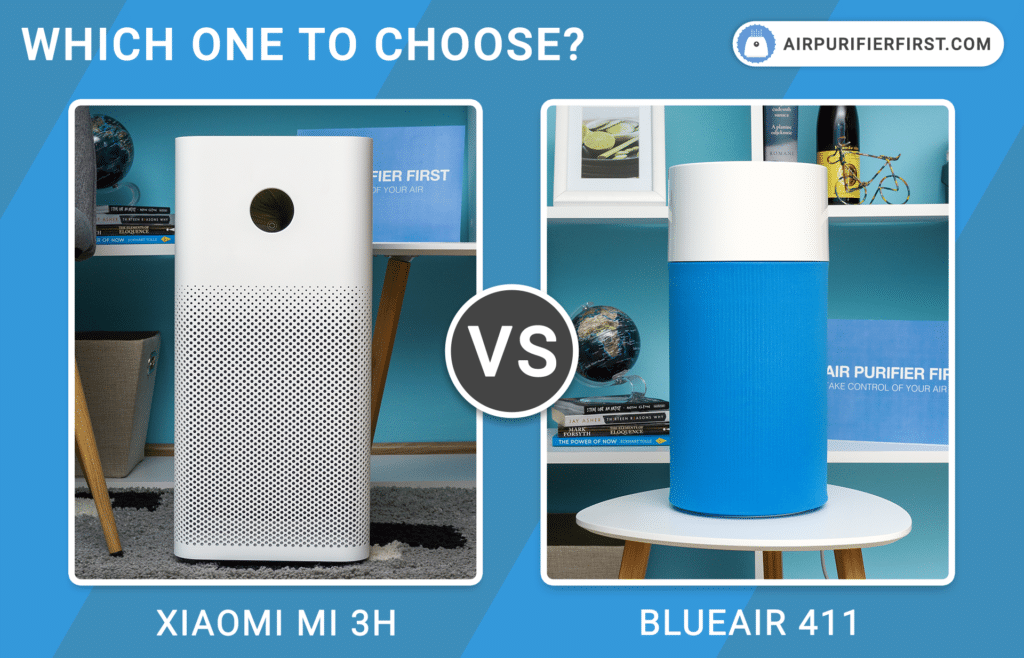
Table of Contents
Comparing both air purifiers, you’ll notice lots of specifications that work in favor of Blueair, such as the Ionizer, product price, or power consumption. But, Xiaomi still has a lot to offer, like numerous features that level up the overall performance making this air purifier a powerful tool in your home environment.
Blueair is the type of air purifier that’s designed for small interiors, such as bedrooms, offices, and even nurseries. You get to buy it in white color, but with 5 different pre-filter colors, such as Dark Shadow and Diva Blue, which make it adaptable to various interior decor styles.
Mi Air purifier is the kind of air purifier you are prone to just for the brand itself. But, keep in mind that this device has a lot more to offer than just a name. The fact that it’s a whisper-quiet device and that you can control it with voice commands speaks for itself. This one you can find only in white color. Personally, I think that whites are what bring up the elegance and design quality of this product.
Take a closer look at what both air purifiers have to offer.
Blueair and Xiaomi Specifications
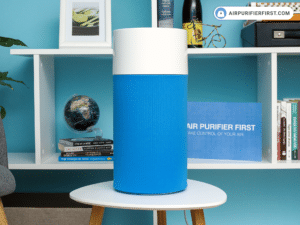 |
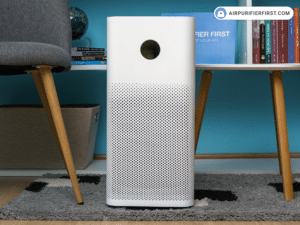 |
|
| Manufacturer | Blueair | Xiaomi |
| Model | Blue Pure 411 | Mi 3H |
| Dimensions | 16.7 x 8 x 8 inches | 9.5 x 9.5 x 20.5 inches (24 x 24 x 52 cm) |
| Room Coverage (4.8 ACH) | 161 sq. ft. | 484 sq. ft. (45 m2) |
| Performance Ratings | ||
| Filtration Technology | Washable Pre-filter, Particle Filter, and Carbon Filter | Pre-filter, True HEPA and Active Carbon Filter |
| Filter Replacement Indicator | Yes | Yes |
| Filter Longevity | 6-8 months | 6-12 months |
| Power | 10W | 38W |
| Operating Costs Ratings | ||
| Fan Speeds | 3 – Speed 1, Speed 2, and Speed 3 | 6 – Automatic Mode, Sleep Mode, Speed 1, Speed 2, Speed 3, and Manual Mode |
| Air Quality Sensor | No | Yes |
| Air Quality Indicator | No | Yes |
| Auto Mode | No | Yes |
| Smart App | No | Yes |
| Voice Control | No | Yes |
| Noise Levels | 40.6 – 67.5 dBA | 40.9 – 65.4 dBA |
| Noise Ratings | ||
| Warranty | 2-year | 1-year |
| In-Depth Review | Blueair 411 | Xiaomi Mi 3H |
| Price | Check Price on Amazon | Check Price on Amazon |
Features Overview
Regarding all that’s been said on both air purifiers, we can easily refer to Xiaomi Mi 3H as advanced, with Blueair Blue Pure 411 keeping it minimalistic at the same time.
As you can see, Blueair is quite smaller than the Mi 3H, which is exactly what manufacturers’ features point out. With that in mind, Mi 3H can clean up to 3 times bigger space than the Blueair. Therefore, be aware of the dimensions when deciding on which one to buy.
Minimalistic as it is, Blueair Blue Pure 411 comes with only one control button, with no advanced features whatsoever. However, it does have some interesting options such as memory of the last used speed and the possibility to use the smart plug, since it turns ON the minute the air purifier is connected to power.
Contrary to Blueair, Mi 3H comes with a variety of advanced features such as Auto Mode, Air Quality Sensor/Indicator, and, most interesting of all, a Smart App. So, let’s cut to the chase.
Controls
As I already mentioned in the previous section, having a single control button is what simplifies the usage of the Blueair Blue Pure 411 air purifier. You can find it on the upper side and control the device with a soft touch. That way, not only can you turn ON/OFF your air purifier but also switch between fan speeds and filter reset functions.
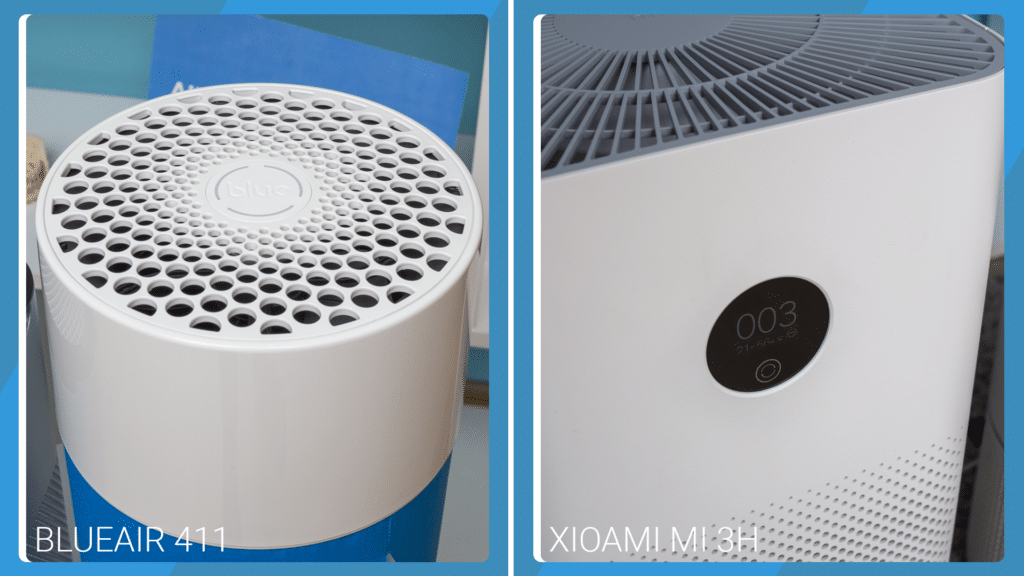
Although sometimes we like to keep things easy, Xiaomi Mi 3H is an example where less isn’t always more. Given its numerous functions, Xiaomi demands a bit more effort if you want full use of its potential. With that said, you will find a frontally positioned button with whom you can power ON or OFF, change operating modes, etc. And if you want a little bit advanced control system, simply download the Mi Home app, and you will be able to control your device from any location.
Air Quality Sensor and Indicator
Air Quality Sensor and Indicator are features that Blueair is missing, and this is why Xiaomi gets an extra point. This sensor can detect real-time particles by displaying the amount of PM2.5 particles. The current air quality will then be displayed on both the air purifier and your Smart App. As for the Indicator, its color will depend on the air quality in the room.
There are some extra features that Xiaomi Mi 3H offers, like temperature and humidity sensors, and it really gives you an extra perspective on the real-time air quality. If you want to know more about it, follow the link to get the whole picture of this air purifier.
Working Modes
This is the part where you don’t get many options to use your air purifier. Since Blueair Blue Pure 411 model is missing out on operating modes, you can only use its button to switch between fan speeds. The good news, though, is that the upcoming fellow model, Blueair 411 Auto, comes with an integrated Auto Mode.
On the other hand, Xiaomi Mi 3H is full of different working modes. The one mode I like the most is exactly the previously mentioned Auto Mode, and here is why. Once you set your air purifier into Auto Mode, it will connect to the Air Quality Sensor and, based on the current air quality, start switching gears. That way, you can rely on the air purifier’s efficiency. Another cool feature is the Sleep Mode, which allows you to use this device in your bedroom, especially while sleeping.
And last but not least, there is also Manual Mode which you can only use by sliding through your Smart App.
Display Off
Having a Display off option can be quite handy. You may not need it all the time, but once you do, you’ll see the difference.
Blueair Blue Pure 411 comes without this option, but if your air purifier is dull for at least 5 seconds, all the indicators will decrease the light to about 10% of its power.
With Xiaomi Mi 3H, you get the possibility to turn off the indicators on its display by simply pressing the rear-side button. Also, you can do the same thing with your Smart App.
Google Assistant and Amazon Alexa Integration
For those of you eager to make a smart home, Xiaomi Mi 3H is there to offer complete assistance so you can always rely on your smart appliances. Not only can you connect your cell phone to your air purifier, but you can also use the benefits of Google Assistant or Amazon Alexa. If you remember me mentioning voice commands, well, this is it. It will definitely make your life a lot easier.
If you prefer having these options, then Blueair Blue Pure is not your type of air purifier.
Airflow
Looking at both of these air purifiers, you might think that their filtration process differs since one is cylindrically and the other is rectangularly shaped. The truth is, there’s not much of a difference.
Both Xiaomi Mi 3h and Blueair Blue Pure 411 have bottom air suction through holes that take up to 2/3rds of the appliance. The air comes in all around the Blueair, as opposed to the rear side holes of Xiaomi.
Once the air is filtered, it comes out on the upper side and spreads over the room.
Warranty
While Xiaomi Mi 3H comes with a 1-year warranty, Blueair Blue Pure 411 offers a 2-year coverage but only if you register on their website straight upon the purchase.
Just for the record, Blueair provides the shortest warranties for their Blue Pure appliances, while the Classic series can obtain even a 5-year warranty.
Filtration Technology
To begin with, both air purifiers use a 3-stage filtration process, with the addition of HEPA silent technology in the Blueair 411 device.
The first stage, as usual, belongs to a pre-filter in both air purifiers. Blueair’s pre-filter is made of fabric that you can pull on and off when needed, so there is no excuse for not washing it. At the same time, Xiaomi’s non-washable pre-filter collects all the great pollutants such as dust particles, hair, etc., while at the same time preventing the HEPA filter from clogging and, therefore, extending its duration.
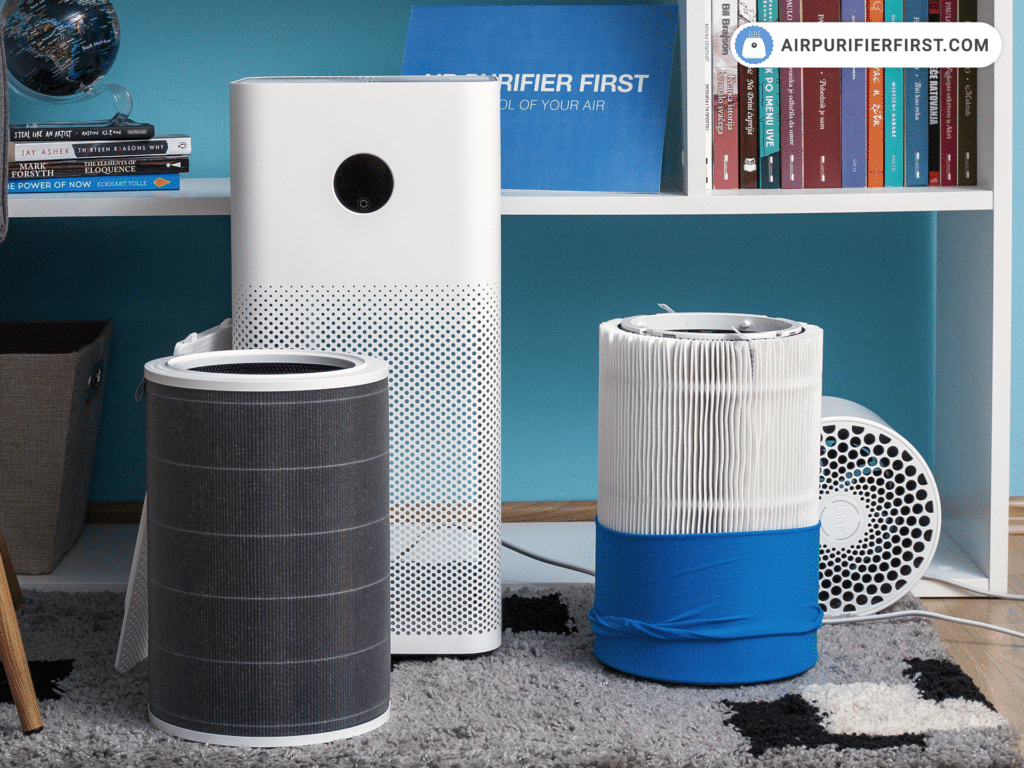
The second stage of a Blueair 411 air purifier is the main ‘’particle’’ filter that does most of the job by removing 99% of airborne particles. The True HEPA filter is the second filter in Xiaomi Mi 3H with an assignment of removing PM2.5 particles and many other up to 0.3 microns small allergens, like dust, pollen, or pet dander.
And, as for the third filtration stage in Blueair 411, that would be a fibrous carbon filter. It is designed to neutralize all the smelly and gassy odors from your living space. Still, if you are a passionate smoker, don’t expect much from this air purifier because its carbon filter does not contain a lot of carbon. That is why this air purifier will not help collect all the smoke from the last night’s party.
On the other hand, the activated carbon filter in Xiaomi is pretty efficient in removing the unwanted odors and smoke from your private area due to its carbon pellets collection. All those toxic components of your everyday cleaning products like formaldehyde will be processed and neutralized.
How To Replace Filter On Both These Devices?
Even though Blueair 411 and Xiaomi Mi 3H have different shapes, they share about the same cylindrically shaped filters, hollow on the inside. As I mentioned before, it is important to know if the pre-filter is washable.
Anyway, it takes at least 6 months before you’ll need to check up on your air purifiers’ filters. It can take up to 8 months in the case of Blueair 411 and up to a year for Xiaomi before you have to replace them.
No matter how you decide to clean them, with a dry cloth or a vacuum cleaner, you have to be aware of this necessity if you want your new appliance to hold on against all odds. Proper maintenance is the key to long-lasting.
Noise Test
Besides the regular three levels of fan speed that both air purifiers have, Xiaomi Mi 3H has an additional Sleep and Manual mode.
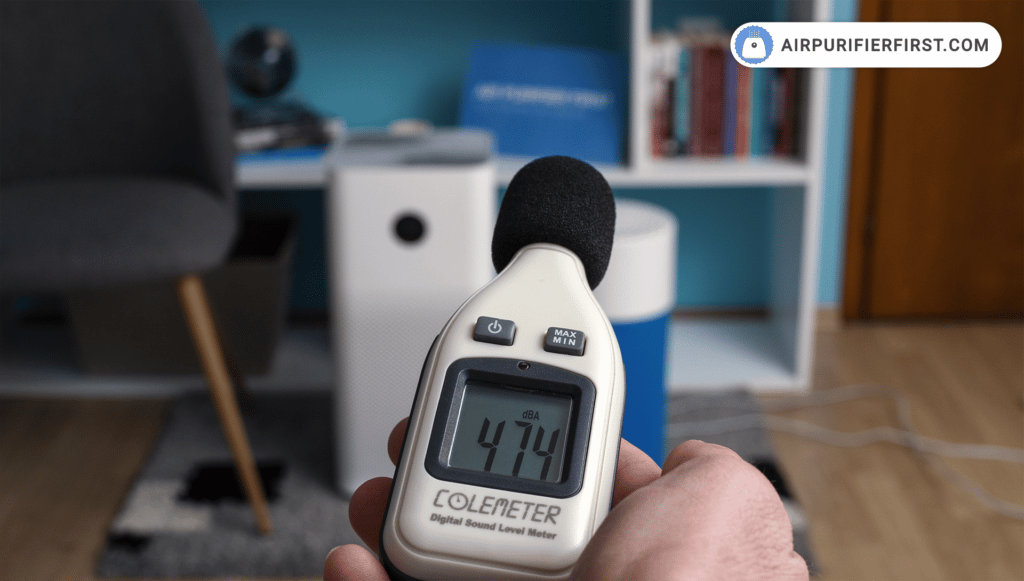
I must say, I was a bit surprised because both air purifiers showed approximately the same test results. While working on their lower speeds, Blueair 411 and Xiaomi Mi 3H are doing just fine, even pleasant. Once the speed rises to its third level, Blueair tends to buzz a little, which is fine. Still, to some of you, it may be annoying. Xiaomi’s motor is generally well-optimized, which makes it work smoothly with no unpleasant noises.
| Product | Noise Range (dBA) |
|---|---|
| Xiaomi Mi 3H | 40.9 – 65.4 dBA |
| Blueair 411 | 40.6 – 67.5 dBA |
Both air purifiers aside, you have to keep in mind that any air purifier must be noisier once you set it to the maximum speed. It’s the point of their maximum efficiency, which is essentially the main reason for buying this type of appliance.
Performance Tests
In case you missed it in the comparison table, I will point out the fact that Blueair 411 and Xiaomi Mi 3H are designed to cover entirely different room sizes. Blueair is meant to clean up to 161 sq. ft. of living or working space, while Xiaomi does even more by purifying the air in up to 484 sq. ft. of your surroundings.

With that in mind, I had to put both Blueair and Xiaomi through various tests only to be sure of their performances. However, the optimal results could only be reached by having both air purifiers tested in the same room size. That’s why I picked a 320 sq. ft. room size.
320 sq. ft. Room Tests
Before I tested both air purifiers in a 320 sq. ft. room, I’ve put them in their designated room sizes to be sure of their performances. I must admit how pleasantly surprised I was since Blueair 411 and Xiaomi Mi 3H were quite impressive. That’s when I decided to put them in the same room size, and I was even more surprised to see how well they did their job.
Approximately 90% of the air was purified by the Blueair 411 and about 95% by Xiaomi Mi 3H.
320 sq. ft. Room
* Data measuring time is 60 minutes.
And even though Blueair has a bit of delay as opposed to Xiaomi, in filtering all the gasses, I can’t help but recommend both air purifiers.
Other Tests
As I was saying, I tested Blueair and Xiaomi in other room sizes, approximately similar to their designated ones, and here’s how it resulted.
Blueair 411 had improved the air quality of a 194 sq. ft. room size by 95%, in only 60 minutes of the highest speed level.
At the same time, Xiaomi Mi 3H was left for an hour in a 560 sq. ft. living room area on a maximum speed level, and it ended up in 90% purified air.
Extraordinary results, don’t you agree?
Operating Costs
Somehow, I believe that, by the time I get to this ‘’operating’’ part, some of you already have their opinion on which product is better and worth buying. Still, the comparison wouldn’t be complete without this section.
Xiaomi Mi 3H uses almost four times more power than Blueair 411, which makes its filter price, accordingly, higher.
On a monthly basis, if you leave both air purifiers constantly working at maximum speed level, you will end up with a 3.4$ bill for using Xiaomi and even less than a dollar bill for Blueair.
| Product | Wattage Range (W) |
|---|---|
| Xiaomi Mi 3H | 0.9 – 39W |
| Blueair 411 | 0.3 – 7.6W |
As you can see, Blueair 411 is not an energy-waster, and with such an airflow, I must give credit to designers for creating this low-cost/high-end product.
Even though Xiaomi Mi 3H feels like an energy drainer, I can’t help but acknowledge the fact that its motor is working fully optimized and with much better airflow.
All of this leads me to the conclusion that Blueair 411 is a much cheaper and affordable solution than Xiaomi Mi 3H.
Which One Does It Better?
Let us summarize together all the pros that work in favor of both air purifiers.
On one side, we have a Xiaomi Mi 3H, a remarkable and almost noiseless air purifier with plenty of advanced options and better performance in general.
On the other side, a Blueair 411 air purifier will catch your attention with its minimalistic appearance and great performance while still helping you save your money.
Though I think that Blueair is also a good choice, my final decision goes in favor of the Xiaomi Mi 3H thanks to its numerous features and overall almost impeccable performance.
What do you think about both of these air purifiers? Would you make a different call, and why? Tell me more about it in the comments section below.
Great review.
One note though… the bar chart shows the results swapped around.
I believe it should show the Xiaomi Mi 3H at 95% and the Blueair 411at 90% on the bar chart.
Thanks a lot for letting me know about this mistake!
Thank you for this comprehensive review! This definitely help my decision to buy one.
I’m glad to hear that!